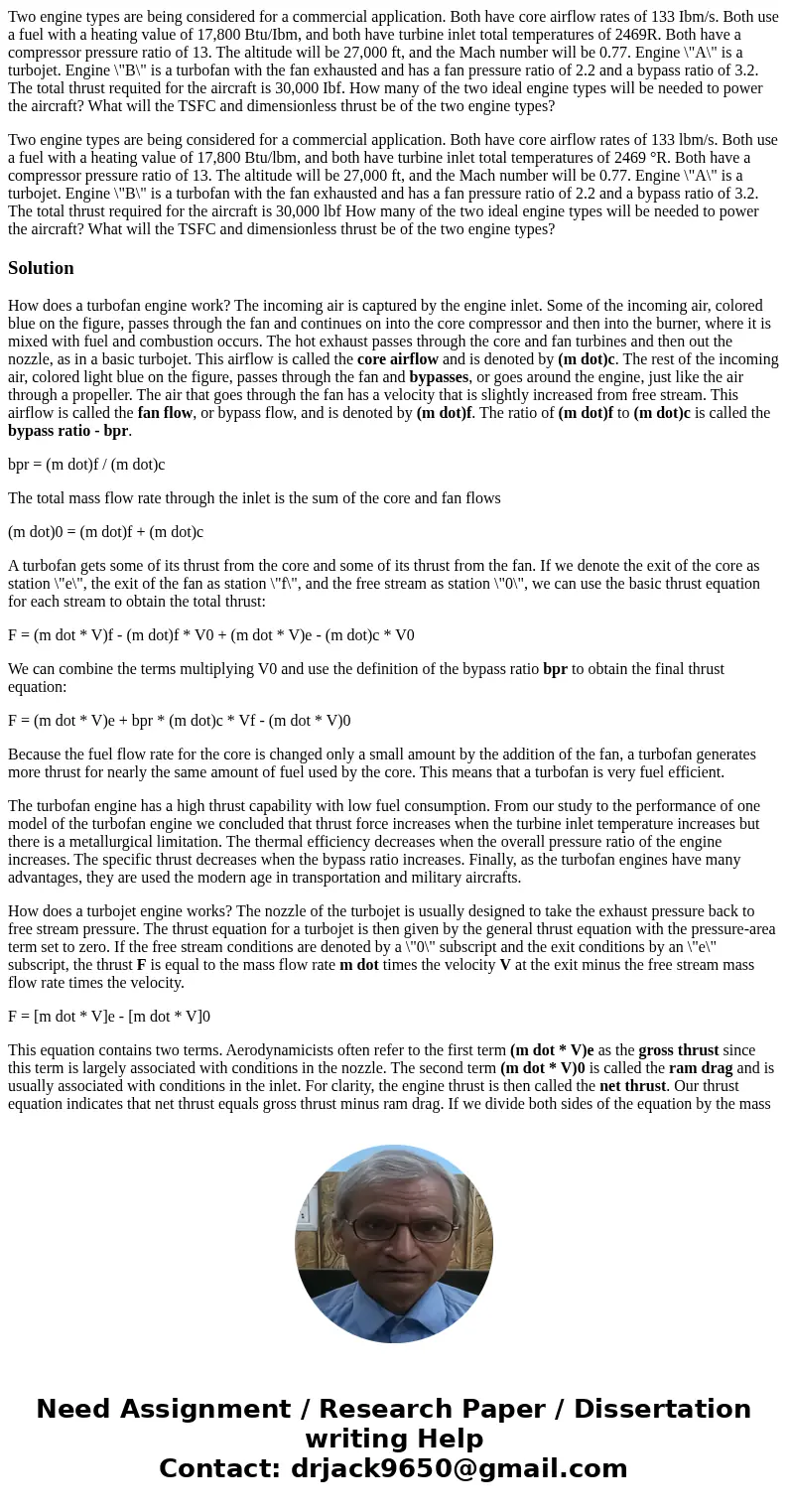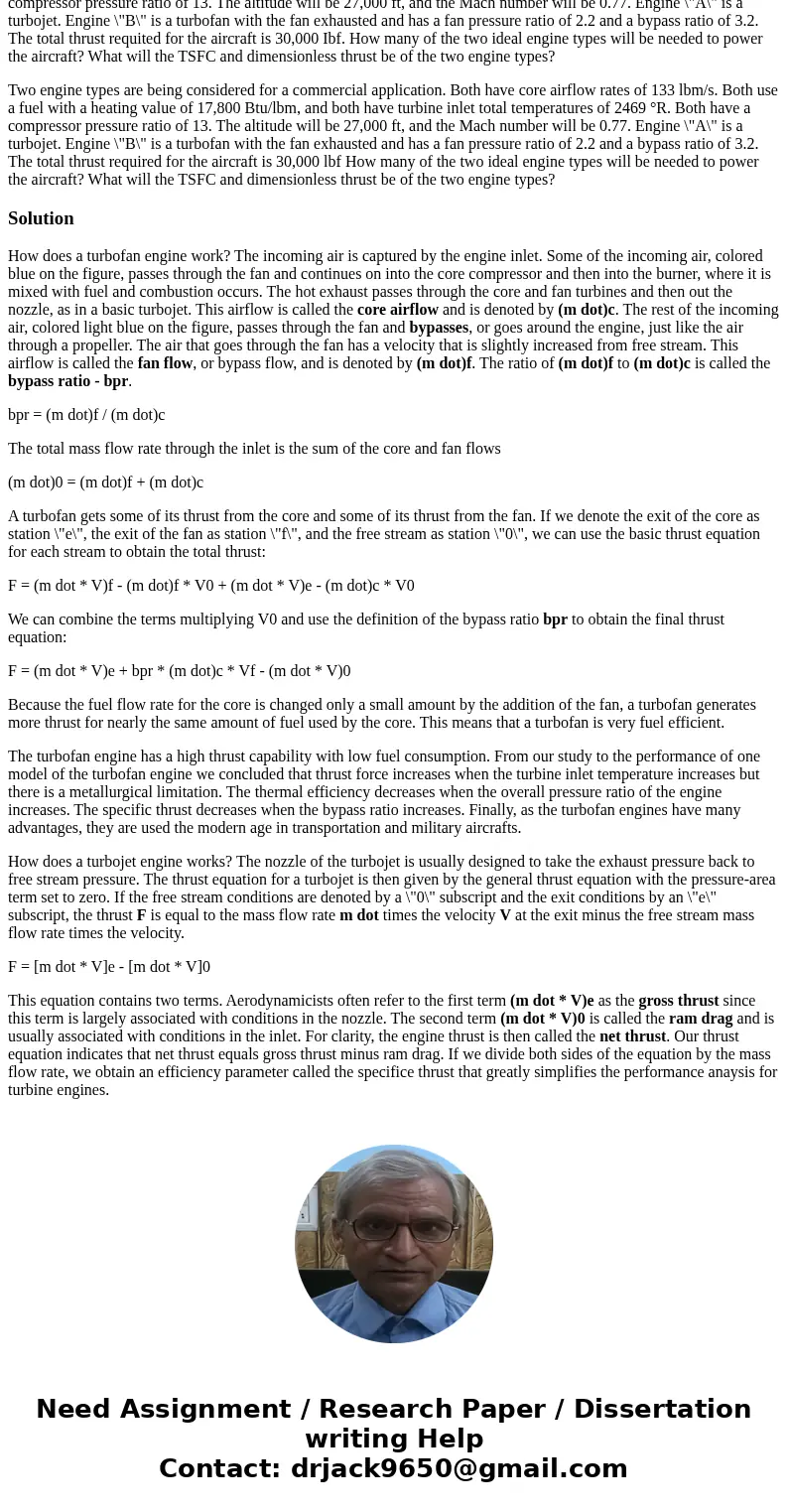Two engine types are being considered for a commercial appli
Two engine types are being considered for a commercial application. Both have core airflow rates of 133 Ibm/s. Both use a fuel with a heating value of 17,800 Btu/Ibm, and both have turbine inlet total temperatures of 2469R. Both have a compressor pressure ratio of 13. The altitude will be 27,000 ft, and the Mach number will be 0.77. Engine \"A\" is a turbojet. Engine \"B\" is a turbofan with the fan exhausted and has a fan pressure ratio of 2.2 and a bypass ratio of 3.2. The total thrust requited for the aircraft is 30,000 Ibf. How many of the two ideal engine types will be needed to power the aircraft? What will the TSFC and dimensionless thrust be of the two engine types?
Two engine types are being considered for a commercial application. Both have core airflow rates of 133 lbm/s. Both use a fuel with a heating value of 17,800 Btu/lbm, and both have turbine inlet total temperatures of 2469 °R. Both have a compressor pressure ratio of 13. The altitude will be 27,000 ft, and the Mach number will be 0.77. Engine \"A\" is a turbojet. Engine \"B\" is a turbofan with the fan exhausted and has a fan pressure ratio of 2.2 and a bypass ratio of 3.2. The total thrust required for the aircraft is 30,000 lbf How many of the two ideal engine types will be needed to power the aircraft? What will the TSFC and dimensionless thrust be of the two engine types?Solution
How does a turbofan engine work? The incoming air is captured by the engine inlet. Some of the incoming air, colored blue on the figure, passes through the fan and continues on into the core compressor and then into the burner, where it is mixed with fuel and combustion occurs. The hot exhaust passes through the core and fan turbines and then out the nozzle, as in a basic turbojet. This airflow is called the core airflow and is denoted by (m dot)c. The rest of the incoming air, colored light blue on the figure, passes through the fan and bypasses, or goes around the engine, just like the air through a propeller. The air that goes through the fan has a velocity that is slightly increased from free stream. This airflow is called the fan flow, or bypass flow, and is denoted by (m dot)f. The ratio of (m dot)f to (m dot)c is called the bypass ratio - bpr.
bpr = (m dot)f / (m dot)c
The total mass flow rate through the inlet is the sum of the core and fan flows
(m dot)0 = (m dot)f + (m dot)c
A turbofan gets some of its thrust from the core and some of its thrust from the fan. If we denote the exit of the core as station \"e\", the exit of the fan as station \"f\", and the free stream as station \"0\", we can use the basic thrust equation for each stream to obtain the total thrust:
F = (m dot * V)f - (m dot)f * V0 + (m dot * V)e - (m dot)c * V0
We can combine the terms multiplying V0 and use the definition of the bypass ratio bpr to obtain the final thrust equation:
F = (m dot * V)e + bpr * (m dot)c * Vf - (m dot * V)0
Because the fuel flow rate for the core is changed only a small amount by the addition of the fan, a turbofan generates more thrust for nearly the same amount of fuel used by the core. This means that a turbofan is very fuel efficient.
The turbofan engine has a high thrust capability with low fuel consumption. From our study to the performance of one model of the turbofan engine we concluded that thrust force increases when the turbine inlet temperature increases but there is a metallurgical limitation. The thermal efficiency decreases when the overall pressure ratio of the engine increases. The specific thrust decreases when the bypass ratio increases. Finally, as the turbofan engines have many advantages, they are used the modern age in transportation and military aircrafts.
How does a turbojet engine works? The nozzle of the turbojet is usually designed to take the exhaust pressure back to free stream pressure. The thrust equation for a turbojet is then given by the general thrust equation with the pressure-area term set to zero. If the free stream conditions are denoted by a \"0\" subscript and the exit conditions by an \"e\" subscript, the thrust F is equal to the mass flow rate m dot times the velocity V at the exit minus the free stream mass flow rate times the velocity.
F = [m dot * V]e - [m dot * V]0
This equation contains two terms. Aerodynamicists often refer to the first term (m dot * V)e as the gross thrust since this term is largely associated with conditions in the nozzle. The second term (m dot * V)0 is called the ram drag and is usually associated with conditions in the inlet. For clarity, the engine thrust is then called the net thrust. Our thrust equation indicates that net thrust equals gross thrust minus ram drag. If we divide both sides of the equation by the mass flow rate, we obtain an efficiency parameter called the specifice thrust that greatly simplifies the performance anaysis for turbine engines.


 Homework Sourse
Homework Sourse